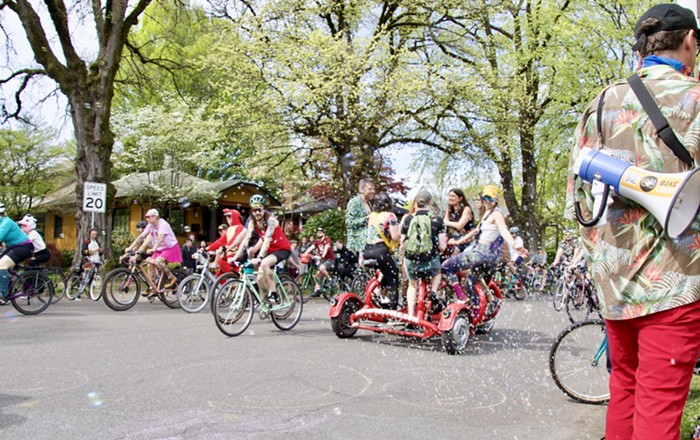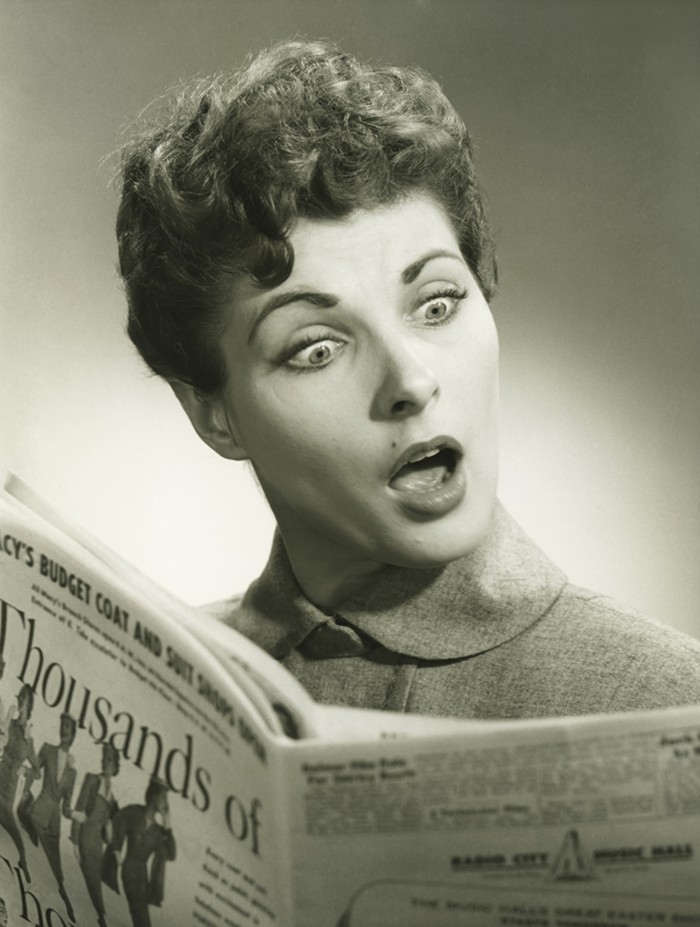TO UNDERSTAND what's wrong with bicycling in Portland today, start with one of the city's signature triumphs.
In 2008, the US Census Bureau found 6 percent of Portlanders were riding their bikes to work. It's not an exciting-sounding figure—it would be laughed at in some European countries—but that 6 percent was big news on North American soil.
It meant Portland had more than tripled its cycling commuters in just eight years, a feat that left other bike-forward cities agog. And it gave us the greatest percentage of cyclists of any major American city.
Few conversations about bicycling policy here go long without mentioning the 6 percent. It is at once the city's finest masterstroke and its greatest source of bike-related angst.
Because here's the problem: We haven't budged since 2008. While cities around the country play catch-up, attracting new riders with ambitious new bikeways, Portland still sits stubbornly, maddeningly, at 6 percent.
It's not like we've been static. Since 2008, the city's passed an ambitious bike plan, and the Portland Bureau of Transportation (PBOT) continues to improve the 336-mile bikeway network—a network that remains the country's best, regardless of census findings. Even if the city's had trouble attracting more people to cycling, of late, it's hard to be mad that Portland's merely less dominant than it used to be.
But that's exactly why 6 percent has been so hard to surpass. If Portland wants to reach its potential, Portlanders may have to get mad. The city's old playbook is no longer enough, and worries that Portland's finally lost its bike mojo have grown louder, in just the past few weeks, than at any point in recent history.
To figure out where we stand, the Mercury spoke with almost 20 people who've helped shaped Portland's amazing bicycle culture in the past 25 years. Their opinions differ, but nearly every one of them thinks Portland may have gotten a flat tire.
So how do we patch it?
PORTLAND'S most recent bout of soul searching began with a Canadian.
On May 5, a Vancouver architect and cycling advocate named Chris Bruntlett wrote an account of a recent visit to the city for Spacing, a Toronto-based urbanism magazine and blog.
The essay began with the sort of praise we've grown used to here. Bruntlett gave appropriate weight and reverence to the city's forward-thinking land-use planning, the more than 100 bike corrals supplanting on-street car parking, and the hundreds of miles of bikeways Portland has built in the last 30 years.
Then he disfigured that image with a couple of sentences.
"The demographic I saw riding downtown certainly suggested to me that only the bold and the brave feel welcome there," Bruntlett wrote, adding that his kids "were forced to walk several stretches on the sidewalk—the ultimate condemnation of any bike network."
Portland's success at attracting cyclists, Bruntlett wrote, "brought with it a sense of complacency; the dangerous notion that Portland had somehow reached a peak, and no more difficult decisions needed to be made."
That chiding—coming from a resident of a Vancouver, BC, a city that's built the kind of sweeping projects Portland can't get off the ground—rocketed through the city's cycling community.
Around the same time, PBOT signaled it was sidelining a proposal to replace parking on a bustling segment of NE/SE 28th with a much-sought bike lane. And on May 12, the enormous downtown mural that for years has welcomed tourists and residents alike to "America's Bicycle Capital," was painted over at the demands of city code enforcers.
It was a symbolic defeat, more than anything, but it stung. The day after the mural's demise, bikeportland.org published an obituary of sorts for the city's bike zeal.
"Something has gone wrong in Portland," the site's news editor, Michael Andersen, headlined his essay—a lengthy and personal retelling of how Portland became one of the continent's shining stars of bicycle policy, and how it's since faded.
"It's time to add another chapter to Portland's bike history," Andersen said. "The moment our bike wave crested."
BEFORE IT CAN CREST, of course, a wave has to build. In Portland, the first stirrings of momentum began more than 40 years ago.
In 1971, Salem passed the so-called "Bicycle Bill," which mandates that at least 1 percent of transportation spending be used on bike and pedestrian projects. Not long after, the City of Portland put together its first bike plan, and launched a "bicycle program." Progress was slow, though. By 1980, Portland's bikeway network included just .3 miles of bike lanes. The rest of its 8.5 miles were off-street paths—great for recreation, but not for biking to the store for eggs.
Things changed in the mid-1990s, when then-City Commissioner Earl Blumenauer was in charge of the Portland Office of Transportation. Blumenauer made it a priority to leverage newly available federal funds for bike projects, and tapped Mia Birk—who now runs Alta Bicycle Share, which is trying to bring bike share to Portland—to build out the city's bicycle network.
About the same time, the fledgling Bicycle Transportation Alliance (BTA) won a lawsuit against the City of Portland finding city leaders needed to explicitly include bike infrastructure in major redevelopment projects.
It all culminated in 1996, when the city passed the Bicycle Master Plan, an ambitious strategy for turning Portland into a bike paradise. Crucially, the city followed through. From 1996 to 1999, Portland added more than 100 bikeway miles, including more than 70 miles of bike lanes. It is far and away the most intense burst of bike infrastructure in Portland's history.
"When we started, a lot of people thought the bike and pedestrian agenda was arts and crafts," says Blumenauer, now a US congressman well known for handing out cheap bike-shaped pins to constituents and colleagues alike. "It wasn't considered central to the mission. So we kicked the bike plan into high gear."
The results—not just the 6 percent, but Portland's bustling and diverse bike culture—are impressive by any measure. In 2008, Portland became the first and only major city to be awarded platinum status by the League of American Bicyclists.
"It's wonderful," says Rex Burkholder, a founder of the BTA and former Metro councilor. "It's beyond my dreams, actually. But it is a question of: Is it sufficient? We're not growing. We haven't been willing to make the hard choices."
Even Blumenauer, who's clearly proud of the city's progress and thinks Portland's on track for greater gains in the future, voiced reservations, saying: "I do think it's time for a gut check."
THAT PORTLAND might have lost its way is all the more surprising given the amount of effort officials expended laying bread crumbs.
Just four years ago, city council passed a bold, uncompromising promise for what the future of cycling in the city would look like: the Portland Bicycle Plan for 2030.
Ushered in by then-Mayor Sam Adams, with enthusiastic support from the city's commissioners, the plan promised a different, better, altogether lovelier Portland.
It called for the city's bike network to increase by 200 percent—and not just via the bike lanes and "neighborhood greenways" that had become Portland's bread and butter. The document demanded marquee "cycle tracks" in some of the city's busiest commercial roads. You've probably seen "cycle tracks" dotted throughout the city. They are bike lanes physically separated from traffic, where riders of any age and ability can feel safe riding amid the bustle.
By 2030, more than 25 percent of all trips within the city would be by bicycle, and the public right-of-way would be "reclaimed for all Portland residents" the plan said. With the amazing network city leaders had in mind, trips of less than three miles would actually seem burdensome to carry out by car. Traffic congestion and pollution would decline, health would improve, and people would put the money they saved on gas and doctor's bills back into the local economy.
"We know what we need to do to make Portland a world-class bicycling city," Adams wrote in a letter at the plan's outset. "Now it is time to be bold in our vision—and successful in our implementation."
But, compared to Blumenauer's earlier effort, expansion under Adams' 2030 plan has been sluggish.
In the four years since the plan was passed, the city's bike network has grown by roughly 50 miles. The vast majority of that progress—41 miles—has come in the form of relatively cheap "neighborhood greenways," stretches of residential streets decorated with markings that signal bikes have priority.
The greenways are popular among cyclists, but a point of contention for advocates: While some people love the quiet routes through Portland, others point out they're not all that different from regular old side streets.
"You don't need to do anything about those," says Burkholder, who thinks the city should be focusing on improving its busiest corridors. "I wanna go to the pub. I wanna get to work fast."
Portland's bike network today stands at 336.1 miles, according PBOT, with funding for nearly 42 more. It's expanded by an average of about 13 miles a year since 2010 (though officials are quick to note they've also improved existing bike lanes). That's less than half the pace needed to achieve 681 new miles in 20 years, as envisioned in the 2030 plan. And, again, the growth has come mostly from the easiest, cheapest projects: neighborhood greenways.
"At the rate we're going," says Chris Smith, a Portland transportation activist and planning commissioner, who sat on the committee that hatched the plan, "it will take 100 years to build out the 20-year bike plan."
THE REASONS are varied and complex. Discretionary funding for bike projects has been drying up since the '90s, city staffers say. And the Great Recession, coupled with Portland's well-publicized paving backlog and the decision to fund huge efforts like the new Sellwood Bridge and light rail, makes it tough to spend millions on bold new bike projects—even if they're vastly cheaper than auto-centric paving, and could cut congestion, reduce pollution, increase wellbeing, and save Portlanders money. These days, what little cash PBOT sets aside for bike projects is used to leverage federal grants—with mixed success.
At the same time, Portland's gotten all the easiest work out of the way. The phrase "low-hanging fruit" comes up repeatedly in conversations about bike planning in this city.
"In the 1990s, the state of the art was a five-foot bike lane separated from the travel lane by a white stripe," says Roger Geller, PBOT's bicycle program coordinator, who's labored to make Portland more bike friendly since Blumenauer oversaw the transportation agency. "Now we're trying to do even more."
There is also the question of leadership. Former Mayor Sam Adams was the city's staunchest bike champion for much of his time in elected office. But insiders say he lost his appetite for the fight in a dust-up over bioswales funding in 2010. Not long after the 2030 plan passed in February of that year, sources say Adams had decided to move on to new battles.
Since taking the mantle in 2013, Mayor Charlie Hales has been more consumed with finding new funding for PBOT than promoting better cycling. Same with Transportation Commissioner Steve Novick.
"We don't have someone driving it right now," sasy BTA Executive Director Rob Sadowsky, who stresses he likes the mayor. "It's not Charlie's fault. It's the electorate that didn't vote for big bold ideas."
And what about the BTA, the organization that successfully won court-approved legitimacy for public bike projects 20 years ago? Sadowsky and Gerik Kransky, the group's advocacy director, say they're taking a more methodical approach these days—working to improve cycling in the entire metro region, not just Portland. It's not sexy or headline grabbing, but they insist the BTA is making progress.
"The more us-vs.-them activism, the harder it is," Sadowsky says. "It probably would be easier for us to whip up a few hundred people to show up downtown, but it would be harder to win votes in Salem. And it would be harder to win votes in Metro if we were the loud angry bicycle advocates that some want us to be."
Not everyone buys that argument. Some observers feel the BTA grew lax with sympathetic leaders like Adams, Burkholder, and former Metro Council President David Bragdon in office.
"My last two years at Metro, they just weren't present," says Burkholder, who served as Metro councilor from 2001 to 2012.
WHAT GROWTH is occurring in Portland's bike network isn't likely to get us over the stubborn 6 percent hump. The city, after all, has already tapped into the confident riders who think nothing of pedaling alongside belching semis and obnoxious BMWs.
What Portland needs, the thinking goes, is to better attract the segment of people—the so-called "interested but concerned," believed to be roughly 60 percent of the population—who would ride a bike if they felt they could do so safely. And to rope those people, advocates, city planners, and economists say we need to do two things.
First, the city has to make equity a focus. With better outreach in North, Northeast, and East Portland, some say the city can easily attract new, enthusiastic riders with minimal expense. A similar strategy underlies Portland's SmartTrips program, which aims to better educate people about navigating the city without a car.
Many advocates also point to Safe Routes to School, an effort that's had success increasing the number of schoolchildren who ride bikes.
"We had a really excellent strategy to get to 6 percent," says Mychal Tetteh, CEO of the nonprofit Community Cycling Center, "but the strategy to get from 6 percent to 12 percent is maybe different. It may be that a focus on people and a focus in culture is what gets you to 12 percent."
But most people argue we also need a better network.
"People have to feel as comfortable getting on the bike as you do getting into your car," says Geller, the city's bike program manager. "There are a lot of things that we can do to encourage people to get on a bike, but once they do get on the bike and give it a shot, we have to make sure their experience is a positive one."
In other words, Portland needs more of the cycle tracks explicitly called for in the 2030 plan—the types of projects that have been unrolled, to great fanfare and success, in cities like Washington, DC, Chicago, New York, and Vancouver, BC ["Protecting the Crown," Feature, June 5, 2013].
Research suggests they're sound investments. A Portland State University study released June 2 looked at cycle tracks in five cities. It concluded they've been highly effective at attracting cyclists, and well worth the trade-offs.
But those same projects often come with fraught conversations and big price tags.
To get a sense of the challenge, look at the recent outcry over a proposed bike lane on NE/SE 28th. The city's suggestion that 100 parking spots might be removed from a stretch of road near the Laurelhurst Theater drew furious protest from business owners in the area, who quickly organized and signed onto a letter opposing the move. PBOT has since parked the bike lane suggestion.
This same push and pull—car parking versus better bike infrastructure—promises to dominate future discussions. Today, less than 1 percent of Portland's bikeway is cycle track.
"When it comes down to it, are we willing to take some things away from automobiles?" asks Smith. "There's a threshold here that Portland has to cross. Chicago can reach that threshold, New York's apparently blown through it. But here in Portland, we're stuck."
NOT ENTIRELY.
Since the 2030 plan passed, PBOT's installed more than half a mile of cycle track on SW Moody near the South Waterfront, and separated 1.2 miles of bike lanes on NE Multnomah from traffic, using planters and paint. The city's added bike-only traffic signals in 11 locations, and around a dozen of its green "bicycle boxes" at Portland stoplights.
And there are plans in the works. "Buffered" bike lanes—set off from cars by an extra wide swath of paint—look likely on SE Foster, and a cycle track near Multnomah Village should commence this month. An enormous, bike-centric retrofit of N Williams is slated to go to bid this year. Two north-south-designated greenway routes through Portland's Eastside are slated to begin shortly.
Portland is progressing, Geller says, even if people don't realize it.
"We promised that we would be on a path to 25 percent, and the needle's not moving much, if at all," he says. "There's a frustration among the public that we are not achieving our potential."
Which gets back to you.
Every person interviewed for this story agreed on one thing: Portland could be making grander, quicker strides if elected leaders sensed more demand, more outrage, more enthusiasm.
The 6 percent figure isn't just stubbornly refusing to move. It's being coddled into place by the 6 percent of Portlanders who whistle into work each day on our city's impressive but flawed bike network, without a thought toward demanding things get better.
If Portland's bike wave has crested, the momentum for a new one isn't going to come from the politicians pleading with you to pay a street fee and scrambling to keep control of the city's water system. It's got to come, as it always has, from the voices of people who realize what Portland could be, and are dedicated to realizing that potential.
"There are a lot of people who'd rather take advantage of the network than pound away for what it's going to be in 20 years," Blumenauer says. "We need as many activists as possible at any given point. That's something the cycling community needs."














